Showing Spotlights 2065 - 2072 of 2856 in category All (newest first):
 A very ambitious idea that has been kicked around for the past couple of years has gained a lot of momentum over the past few months. The vision that, if realized, would be a true energy revolution, is called Desertec and would amount to the biggest solar energy project of all times. The project, if realized, will cost 400-500 billion euros ($550-700 bn) and deliver its first energy in about 10 years. The basic idea is to install a huge network of concentrating solar-thermal power plants in the Sahara desert and build a network of High-Voltage Direct Current transmission lines to carry the electricity to Europe. The Desertec concept describes the perspective of a sustainable supply of electricity for Europe, the Middle East and North Africa up to the year 2050. By then, it could satisfy as much as 15 percent of the European Union's power needs. It shows that a transition to competitive, secure and compatible supply is possible using renewable energy sources and efficiency gains, and fossil fuels as backup for balancing power. Also, the technology exists today - it's the scale of the vision that's revolutionary.
A very ambitious idea that has been kicked around for the past couple of years has gained a lot of momentum over the past few months. The vision that, if realized, would be a true energy revolution, is called Desertec and would amount to the biggest solar energy project of all times. The project, if realized, will cost 400-500 billion euros ($550-700 bn) and deliver its first energy in about 10 years. The basic idea is to install a huge network of concentrating solar-thermal power plants in the Sahara desert and build a network of High-Voltage Direct Current transmission lines to carry the electricity to Europe. The Desertec concept describes the perspective of a sustainable supply of electricity for Europe, the Middle East and North Africa up to the year 2050. By then, it could satisfy as much as 15 percent of the European Union's power needs. It shows that a transition to competitive, secure and compatible supply is possible using renewable energy sources and efficiency gains, and fossil fuels as backup for balancing power. Also, the technology exists today - it's the scale of the vision that's revolutionary.
Jul 13th, 2009
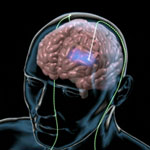 Neural interfaces used for such purposes as electroencephalography are noninvasive, but suffer from relatively poor spatial and temporal resolution of signals. The type of neural interface that uses electrodes inserted in the brain and measures neuronal activities is more effective, but might leave behind irreversible lesions in the cerebrum because of the need to implant electrodes in brain tissue. Other problems with this type of neural interface include the difficulty of obtaining information about individual organs. Believing that an effective solution to these problems lies in designing a neural interface that attaches not to the cerebrum but to peripheral nerves, scientists in Japan have developed an electrode for a peripheral nerve interface.
Neural interfaces used for such purposes as electroencephalography are noninvasive, but suffer from relatively poor spatial and temporal resolution of signals. The type of neural interface that uses electrodes inserted in the brain and measures neuronal activities is more effective, but might leave behind irreversible lesions in the cerebrum because of the need to implant electrodes in brain tissue. Other problems with this type of neural interface include the difficulty of obtaining information about individual organs. Believing that an effective solution to these problems lies in designing a neural interface that attaches not to the cerebrum but to peripheral nerves, scientists in Japan have developed an electrode for a peripheral nerve interface.
Jul 9th, 2009
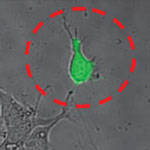 The Atomic Force Microscope (AFM) is a key tool for nanotechnology. This instrument has become the most widely used tool for imaging, measuring and manipulating matter at the nanoscale and in turn has inspired a variety of other scanning probe techniques. Originally the AFM was used to image the topography of surfaces, but by modifying the tip it is possible to measure other quantities (for example, electric and magnetic properties, chemical potentials, friction and so on), and also to perform various types of spectroscopy and analysis. Increasingly, the AFM is also becoming a tool for nanofabrication. Relatively new is the use of AFM in cell biology. Researchers in Switzerland have now demonstrated novel cell biology applications using hollow force-controlled AFM cantilevers - a new device they have called FluidFM.
The Atomic Force Microscope (AFM) is a key tool for nanotechnology. This instrument has become the most widely used tool for imaging, measuring and manipulating matter at the nanoscale and in turn has inspired a variety of other scanning probe techniques. Originally the AFM was used to image the topography of surfaces, but by modifying the tip it is possible to measure other quantities (for example, electric and magnetic properties, chemical potentials, friction and so on), and also to perform various types of spectroscopy and analysis. Increasingly, the AFM is also becoming a tool for nanofabrication. Relatively new is the use of AFM in cell biology. Researchers in Switzerland have now demonstrated novel cell biology applications using hollow force-controlled AFM cantilevers - a new device they have called FluidFM.
Jul 8th, 2009
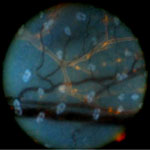 The usefulness of quantum dots comes from their peak emission frequency's extreme sensitivity to both the dot's size and composition. QDs have been touted as possible replacements for organic dyes in the imaging of biological systems, due to their excellent fluorescent properties, good chemical stability, broad excitation ranges and high photobleaching thresholds. In order for quantum dots to be useful as as nanoemitters for biological imaging, they need to be linked with a specific sensor molecule that exclusively targets a biomolecule of interest. These conjugations are usually made using small linker molecules although this often demands multistep procedures and may suffer from QD colloidal instabilities during the coupling reactions. Demonstrating hyaluronic acid-QD conjugates, researchers in Korea have now solved this problem by simple electrostatic conjugation which offers stable and size-tunable conjugates.
The usefulness of quantum dots comes from their peak emission frequency's extreme sensitivity to both the dot's size and composition. QDs have been touted as possible replacements for organic dyes in the imaging of biological systems, due to their excellent fluorescent properties, good chemical stability, broad excitation ranges and high photobleaching thresholds. In order for quantum dots to be useful as as nanoemitters for biological imaging, they need to be linked with a specific sensor molecule that exclusively targets a biomolecule of interest. These conjugations are usually made using small linker molecules although this often demands multistep procedures and may suffer from QD colloidal instabilities during the coupling reactions. Demonstrating hyaluronic acid-QD conjugates, researchers in Korea have now solved this problem by simple electrostatic conjugation which offers stable and size-tunable conjugates.
Jul 7th, 2009
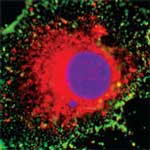 A group of researchers at the Technical University of Denmark have conducted a systematic analysis of 31 recently published reports and articles which discuss the environmental, health, and safety aspects of nanomaterials. They find that serious knowledge gaps pervade nearly all areas of basic nanotechnology EHS knowledge. These knowledge gaps or areas of uncertainty were ranked to how often they were included in the screened literature. The analysis found that the following areas in particular have been highly cited as important knowledge gaps within the field: the lack of reference materials and standardization; environmental fate and behavior; human and environmental toxicity; test methods to assess, particularly, the effects, and commercial or industrial-related aspects (e.g. life cycle assessments).
A group of researchers at the Technical University of Denmark have conducted a systematic analysis of 31 recently published reports and articles which discuss the environmental, health, and safety aspects of nanomaterials. They find that serious knowledge gaps pervade nearly all areas of basic nanotechnology EHS knowledge. These knowledge gaps or areas of uncertainty were ranked to how often they were included in the screened literature. The analysis found that the following areas in particular have been highly cited as important knowledge gaps within the field: the lack of reference materials and standardization; environmental fate and behavior; human and environmental toxicity; test methods to assess, particularly, the effects, and commercial or industrial-related aspects (e.g. life cycle assessments).
Jul 3rd, 2009
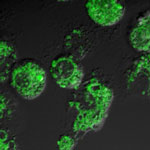 Environmental and behavioral factors may lead the body to produce superoxide radicals known as reactive oxygen species (ROS) that could cause cell damage through oxidation. Oxidative stress from ROS is implicated in aging and most diseases including cancer, heart disease, liver fibrosis, neurodegenerative diseases, autoimmune disorders. An excess of these reactive molecules can lead to oxidative stress and cellular damage, and toxicologists have identified ROS generation as a likely mechanism of nanoparticle toxicity. Since ROS plays an important role in various pathogenic processes, it has been recognized as an early indicator for cytotoxic events and cellular disorders. However, conventional chemical ROS probes have not fulfilled the rising need of in vitro and in vivo analysis of ROS generation due to auto-oxidation problems and poor specificity and sensitivity. Scientists in South Korea have now demonstrated a novel ROS-sensitive gold nanoprobe prepared from bio-inspired immobilization of fluorescein-labeled hyaluronic acid onto the surface of gold nanoparticles. This probe is highly stable under exposure to natural light and laser sources and extremely sensitive and specific to certain oxygen species.
Environmental and behavioral factors may lead the body to produce superoxide radicals known as reactive oxygen species (ROS) that could cause cell damage through oxidation. Oxidative stress from ROS is implicated in aging and most diseases including cancer, heart disease, liver fibrosis, neurodegenerative diseases, autoimmune disorders. An excess of these reactive molecules can lead to oxidative stress and cellular damage, and toxicologists have identified ROS generation as a likely mechanism of nanoparticle toxicity. Since ROS plays an important role in various pathogenic processes, it has been recognized as an early indicator for cytotoxic events and cellular disorders. However, conventional chemical ROS probes have not fulfilled the rising need of in vitro and in vivo analysis of ROS generation due to auto-oxidation problems and poor specificity and sensitivity. Scientists in South Korea have now demonstrated a novel ROS-sensitive gold nanoprobe prepared from bio-inspired immobilization of fluorescein-labeled hyaluronic acid onto the surface of gold nanoparticles. This probe is highly stable under exposure to natural light and laser sources and extremely sensitive and specific to certain oxygen species.
Jul 2nd, 2009
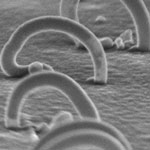 One of the ultimate goals of nanotechnology is to fabricate functional devices at the nanoscale. A nanodevice is expected to integrate components of different material compositions and geometries. The integration is likely to be carried out on silicon if information processing is required. Thus far, the basic building blocks for nanodevices are nanoparticles, for which there are many material candidates; and nanotubes, for which the candidates are fewer (they are mostly carbon, although non-carbon based tubes have been fabricated as well). One-dimensional (1-D) nanomaterials such as nanotubes are useful for component connection and for the transport of charge, heat and vibration. In addition to the limited material selection, common 1-D nanomaterials are usually straight. Composite 1-D nanomaterials are rarer. Often they are also produced as discrete and unorganized units. Scientists in Singapore have now successfully fabricated a family of aligned one-dimensional C-curved nanoarches of different compositions by a simple and scalable method for the first time.
One of the ultimate goals of nanotechnology is to fabricate functional devices at the nanoscale. A nanodevice is expected to integrate components of different material compositions and geometries. The integration is likely to be carried out on silicon if information processing is required. Thus far, the basic building blocks for nanodevices are nanoparticles, for which there are many material candidates; and nanotubes, for which the candidates are fewer (they are mostly carbon, although non-carbon based tubes have been fabricated as well). One-dimensional (1-D) nanomaterials such as nanotubes are useful for component connection and for the transport of charge, heat and vibration. In addition to the limited material selection, common 1-D nanomaterials are usually straight. Composite 1-D nanomaterials are rarer. Often they are also produced as discrete and unorganized units. Scientists in Singapore have now successfully fabricated a family of aligned one-dimensional C-curved nanoarches of different compositions by a simple and scalable method for the first time.
Jul 1st, 2009
 Graphene has two distinct types of edges produced when it is cut - armchair type or zigzag type - which correspond to the two crystal axis of graphene. These edge types are predicted theoretically to have distinct electronic, magnetic, and chemical properties, but current fabrication methods have no way of controlling which type of edge is produced and are dominated by disorder. For example, a common method is to use plasma etching which is an isotropic etching process and is not selective in which crystallographic direction it etches. This is a problem in especially nanoelectronics applications and devices where the potential performance of the device depends strongly on the edge structure as well. A solution to this problem has now been found. Researchers have demonstrated anisotropic etching in single-layer graphene which produces connected graphene nanostructures with crystallographically oriented edges. This opens many future avenues to study graphene nanostructures such as nanoribbons, nanoconstrictions, and quantum dots with crystallographic edges.
Graphene has two distinct types of edges produced when it is cut - armchair type or zigzag type - which correspond to the two crystal axis of graphene. These edge types are predicted theoretically to have distinct electronic, magnetic, and chemical properties, but current fabrication methods have no way of controlling which type of edge is produced and are dominated by disorder. For example, a common method is to use plasma etching which is an isotropic etching process and is not selective in which crystallographic direction it etches. This is a problem in especially nanoelectronics applications and devices where the potential performance of the device depends strongly on the edge structure as well. A solution to this problem has now been found. Researchers have demonstrated anisotropic etching in single-layer graphene which produces connected graphene nanostructures with crystallographically oriented edges. This opens many future avenues to study graphene nanostructures such as nanoribbons, nanoconstrictions, and quantum dots with crystallographic edges.
Jun 30th, 2009
 A very ambitious idea that has been kicked around for the past couple of years has gained a lot of momentum over the past few months. The vision that, if realized, would be a true energy revolution, is called Desertec and would amount to the biggest solar energy project of all times. The project, if realized, will cost 400-500 billion euros ($550-700 bn) and deliver its first energy in about 10 years. The basic idea is to install a huge network of concentrating solar-thermal power plants in the Sahara desert and build a network of High-Voltage Direct Current transmission lines to carry the electricity to Europe. The Desertec concept describes the perspective of a sustainable supply of electricity for Europe, the Middle East and North Africa up to the year 2050. By then, it could satisfy as much as 15 percent of the European Union's power needs. It shows that a transition to competitive, secure and compatible supply is possible using renewable energy sources and efficiency gains, and fossil fuels as backup for balancing power. Also, the technology exists today - it's the scale of the vision that's revolutionary.
A very ambitious idea that has been kicked around for the past couple of years has gained a lot of momentum over the past few months. The vision that, if realized, would be a true energy revolution, is called Desertec and would amount to the biggest solar energy project of all times. The project, if realized, will cost 400-500 billion euros ($550-700 bn) and deliver its first energy in about 10 years. The basic idea is to install a huge network of concentrating solar-thermal power plants in the Sahara desert and build a network of High-Voltage Direct Current transmission lines to carry the electricity to Europe. The Desertec concept describes the perspective of a sustainable supply of electricity for Europe, the Middle East and North Africa up to the year 2050. By then, it could satisfy as much as 15 percent of the European Union's power needs. It shows that a transition to competitive, secure and compatible supply is possible using renewable energy sources and efficiency gains, and fossil fuels as backup for balancing power. Also, the technology exists today - it's the scale of the vision that's revolutionary.
 Subscribe to our Nanotechnology Spotlight feed
Subscribe to our Nanotechnology Spotlight feed





